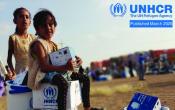Yemen
Operation: Yemen
Location
{"longitude":48,"latitude":16,"zoom_level":0,"iso_codes":"'YEM'"}
By clicking on the icons on the map, additional information is displayed.
The boundaries and names shown and the designations used on this map do not imply official endorsement or acceptance by the United Nations.
Key Figures
| 2020 planning figures | |
| 816,000 | IDPs and 11,350 refugees and asylum-seekers will be assessed through protection monitoring |
| 160,500 | IDPs and 13,000 refugees will receive psychosocial support |
| 124,000 | IDP families and 11,000 refugees will receive protection cash assistance |
| 40,000 | IDP families will receive rental subsidies |
| 1,000 | vocational training courses will empower people of concern, and an additional 1,500 loans will benefit women, youth and people living with disabilities |
| 300 | SGBV survivors will be assisted, including 200 who will receive legal aid and enrol in income-generating activities |
| 102 | IDP sites will benefit from Camp Coordination and Camp Management cluster activities |
| 100% | of SGBV survivors will receive medical care |
| 2018 year-end results | |
| 800,000 | Yemenis and 130,000 refugees were assisted through cash programming |
| 700,000 | people of concern received core relief items |
| 220,000 | people reached through community outreach health activities and 119,000 medical consultations |
| 125,000 | people of concern received emergency shelter kits |
Latest Updates and Related Links
People of Concern
56%
Increase in
2019
2019
| 2019 | 3,974,100 |
| 2018 | 2,551,517 |
| 2017 | 2,419,806 |

[["Refugees",268511],["Asylum-seekers",10682],["IDPs",3625716],["Returned IDPs",69174],["Returned refugees",3],["Others of concern",14]]
Loading ...
Yemen
< Back
2019
{"categories":[2015,2016,2017,2018,2019,2020],"budget":[107.42361363,124.06305842,113.649647797,198.74363653,198.64863682,252.05287273],"expenditure":[59.1504741,76.2339041,70.06427451,135.33389555,139.83043673,null]}
{"categories":[2015,2016,2017,2018,2019,2020],"p1":[54.5338847,48.97075377,63.273753997,95.14566879,48.51471679,83.16849742],"p2":[null,null,null,null,null,null],"p3":[null,null,null,null,null,null],"p4":[52.88972893,75.09230465,50.3758938,103.59796774,150.13392003,168.88437531]}
{"categories":[2015,2016,2017,2018,2019,2020],"p1":[30.6292506,27.28466288,28.77866001,33.77039735,31.84228801,null],"p2":[null,null,null,null,null,null],"p3":[null,null,null,null,null,null],"p4":[28.5212235,48.94924122,41.2856145,101.5634982,107.98814872,null]}
Loading ...
CHOOSE A YEAR
- 2014
- 2015
- 2016
- 2017
- 2018
- 2019
- 2020
Working environment
In 2019, the crisis in Yemen is expected to continue with unprecedented humanitarian needs for UNHCR’s people of concern. Conflict and socio-economic deterioration are expected to continue, resulting in increased protection challenges such as poverty, concomitant deterioration, reliance on extreme negative coping mechanisms, inadequate social services, constrained protection space, elevated psychosocial trauma and continued high levels of internal displacement. UNHCR’s operation in Yemen is further challenged by restricted humanitarian access. UNHCR will continue working closely with central and local authorities and humanitarian partners to implement the 2013 National Displacement Policy while navigating the expectations of the National Authority for the Management and Coordination of Humanitarian Affairs (NAMCHA).With regard to internal displacement in Yemen, in 2019, UNHCR will respond to new displacement, creating and reinforcing protection space; building community resilience; and enabling durable solutions for IDP returnees, against a backdrop of continued security challenges.
Refugees and migrants, mainly from Ethiopia and Somalia, are expected to continue to arrive in Yemen, albeit in smaller numbers, in search of protection or transit to the Arabian Peninsula. They will continue to face challenges such as smuggling, trafficking and restricted access to territory. The more than 282,000 refugees will continue to face increased vulnerabilities, both in the north and south of the country, affecting their livelihood, access and coping abilities.
Restrictive protection space, particularly in the north, and policies of controlled movement continue to subject persons of concern to heightened protection risks. UNHCR is advocating for durable solutions for vulnerable refugees in Yemen, especially extremely vulnerable women and girls of all nationalities, in light of the serious protection risks faced by them in Yemen.
UNHCR will continue its Assisted Spontaneous Return (ASR) programme for Somali refugees, in cooperation with IOM and national authorities in Yemen and Somalia. The ASR programme provides returnees with medical screenings, transportation and cash assistance. UNHCR will also explore the voluntary repatriation of Ethiopians, who, following the election of a new administration in Ethiopia, are expressing the intention to return. As the lead for the Protection and Shelter/NFIs clusters, and the co-lead for the Refugee and Migrants Multi-Sector response, UNHCR will remain actively engaged in the Humanitarian Response Plan (HRP) process in 2019.
Key Priorities
In 2019, UNHCR will focus on:- Providing lifesaving support and legal protection to refugees, asylum-seekers, IDPs and IDP returnees;
- Jointly with the Yemen authorities, ensuring the provision of international protection to refugees arriving and residing in Yemen, in accordance with the 1951 Refugee Convention and its 1967 Protocol to which Yemen is a signatory;
- Maintaining and reinforcing the protection space; implementing durable solutions: ASR, voluntary repatriation and pursuit of out-of-camp policies for refugees in the south;
- Delivering core-relief items, emergency shelter and multi-purpose cash for shelter and protection to IDPs, IDP returnees, and vulnerable refugees and asylum-seekers;
- Increasing partnerships with all humanitarian actors in Yemen with the aim of enhancing coordination mechanisms;
- Advocating for and supporting diverse durable solutions for all people of concern including voluntary return, and other alternative pathways;
- Strengthening protection interventions for returnees and IDPs, particularly through community-based protection networks, provision of legal assistance and psychosocial support with a focus on sexual and gender-based violence survivors;
- Strengthening the capacity of local partners and diversifying partnerships in order to provide effective, efficient and tailor-made humanitarian interventions;
- Supporting the capacity-building of local and national authorities to address protection challenges;
- Improved urban refugee protection monitoring, programming and mainstreaming people of concern within national services and humanitarian development programming;
- Continued support to improve living standards in Kharaz camp, while pursuing transitioning of the camp to government with an area-based, multi-partner response approach.























